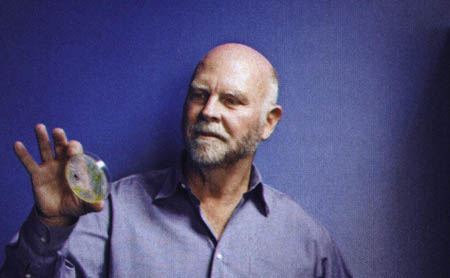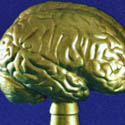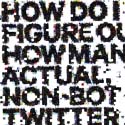Life Hacker
By Thomas Goetz | 05.19.12 1:12 PM

THERE IS ONE VERSION OF Craig Venter's life story where he would've been a dutiful scientist at the National Institutes of Health. a respected yet anonymous researcher in genetics, perhaps. Thankfully, Venter saw that story line developing-and set about making sure it never happened. Instead, in 1992 Venter left the NIH to head the nonprofit Institute for Genomic Research. Six years later he founded Celera Genomics, a brash rival to the NIH project that aimed to sequence the full code of the human genome. Venter had come up with a better technique-known as shotgun sequencing-to get the job done, and it changed the way we translate genetics from proteins into code. Not incidentally, it also served as a model for today's Big Data explosion in science and research. In 2001 Celera officially "tied" the NIH to the genome finish line, though the company's sequence was more than a bit further along. (Celera's model genome, it just so happened, included Venter's own DNA.) In the decade since, Venter has been on a tear of invention and exploration. In 2004 he sailed around the world, discovering thousands of new species and sequencing millions of new genes. In 2007 he unveiled his own genome, unex- purgated (it revealed a predisposition for risk-taking, among other things). And in 2010 he announced the first successful synthesis of life-a unique critter borne from two distinct organisms, thus proving for the first time that it is indeed possible to create new organisms for specific purposes and functions. He is, in every respect, the epitome of an icon-a figure who has pushed science forward, sometimes by sheer force of will. I spoke recently with Venter in San Francisco. at an event hosted by City Arts & Lectures and the California Academy of Sciences. What follows is an edited version of that conversation.
TG: You first made your mark on the International stage when your company, Calera, sequenced the human genome. A decade later, what do you make of that work? How has it panned out?
CV: The last decade has been pretty successful on the technology front. Think about it: The human genome project started as a $3 billion taxpayer initiative in the US with a couple more billion coming from foundations and governments overseas, so a total of about $5 billion. Celera's breakthrough was that we sequenced the human genome for a mere $100 million we had a giant building full of sequencing machines. And now that giant building is condensed to something the size of this table, and that $100 million has been reduced to $1,000 or $2,000. But what most people think about when it comes to genetics is personalized medicine. If we sequence your genome or my genome, what can we interpret, what can we predict for the future, what can we change? That's in its absolute infancy. We're at the point where we don't need one genome or• just a few genomes to interpret your genome. We need tens of thousands of genomes as a starting point, coupled with everything we can know about their physiology It's only when we do that giant computer search, putting all that DNA together, that we will be able to make sense in a meaningful statistical manner of what your DNA is telling you. We're just at the start of trying to do that. So the fact that it's 10 years out and we're able to start on that project- that, I think, is pretty exciting.
TG:There is some perception, though, that In terms of human health the genome revolution has overpromised and under delivered.
CV:Well, it depends on whose promises you're talking about. Some people were saying that 10 years out we'd have every disease cured. I think that was overpromising. I always said it was a race to the starting line. Once we got the first genome, that's when genomics would really start.
TG:I'm curious about your own Interest In human health. Where does that stand on the spectrum of what you're doing?
CV:I turned 65 last year, and each year I get more and more interested in human health. For most people it happens around age 50, but I've always been a slow learner. It's critical in terms of the cost of health care. If we can actually do this experiment of getting at least 10,000 human genomes and then get the corresponding phenotype information, we can show that this data set could make preventative medicine possible and thereby reduce health care costs. And one of the things about genetics that has become clearer as we've done genomes-as we've worked our way through the evolutionary tree, including humans-is that we're probably much more genetic animals than we want to confess we are.
TG:What do you mean by that?
CV:We're much more genetically determined in terms of our physiology. We have 200 trillion cells. and the outcome of each of them is almost 100 percent genetically determined. And that's what our experiment with the first synthetic genome proves, at least in the case of really simple bacteria. It's the interactions of all those separate genetic units that give us the physiology that we see.
TG:So on a cellular level, since the genes control the function of the cell, no matter what happens In that cell's environment, we're more the product of our genes than our environment.
CV:Yes. And that has important consequences when it comes to reading our genomes, trying to understand the basis of disease, and then trying to alter those features. We're a country that seems to love drama and disasters. We're not so good at preventing them. But preventing disease is the future of medicine. That's the only way to lower costs and improve outcomes.
TG:You mentioned synthetic life. This Is another area that you have helped pioneer. It's built on the same raw material-DNA-as your work on the human genome, but It leads us In a very different direction, toward energy solutions, things like that.
CV:The term synthetic life means different things to different people. For some it's green monsters. for others synthetic means plastic. Most people didn't know• what to make of it when we announced that we had created synthetic life. We're talking about chemical synthesis.
TG:You started with a mycoplasma, one of the simplest known bacteria?
CV:In 1995 we sequenced the first genome of a living organism-in fact we sequenced two. For the second, we chose the smallest cell that we could find, with the smallest genome. It was a species called Mycoplasma genitalium. It has only about 500 genes. But we just started asking questions: Could there be an even simpler life form? Could we get down to a minimal cell? And we set up all kinds of experimental ways to knock out genes and eliminate them from mycoplasma itself, whittling away. But due to a lot of complexity, you can't get there experimentally. So we decided that the only way to get there was to make the chromosome-synthetically. Everybody thought this was a very wild idea, because at the time the largest piece of DNA ever made was about 100 times smaller. We had to develop all the technology and ability to do it, and it took us 15 years. What we ended up doing was converting the digital code in the computer into biochemistry. Starting with four bottles of chemicals, we rewrote the analog molecule of DNA. And then we transplanted that synthetic DNA into a regular cell and booted it up, the same way you boot up software on a computer. We call this part of the process genome transplantation. And I think it's the part that surprises people the most. So now we had a cell of one species outfitted with the genetic software of another. In a very short time the cell converted into what the genetic software told it to do. There was no trace of the original species. Every protein in• the cell came from the DNA we'd inserted. So we completely converted one species into another simply by swapping out its software.
TG:And this wasn't just an academic exercise or a stunt. You see a very clear purpose and benefit In this ability to synthesize life for a specific function.
CV:What we published was only a proof of concept. A lot of people say, well, the cell doesn't have any uses. But before we did that experiment most people thought it was impossible, so I think it was a pretty useful experiment as a proof of concept. And now we're working on designing new pathways, trying to get cells to do what we want them to do.
TG:But It 's not like just asking a cell to start making furniture. You're trying to get them to do something that 's close to what they already do naturally.
CV:Right. We're trying to harness photo- synthesis. A key part of photosynthesis is what happens when the sun goes down. Cells convert C02 into sugar and fat molecules. And they store the fat to burn as energy to get them through the night-the same way we store fat only that's just to get us through TV shows. We're trying to coax our synthetic cells to do what's happened to middle America, which is store far more fat than they actually were designed to do. so that we can harness it all as an energy source and use it to create gasoline, diesel fuel, and jet fuel straight from carbon dioxide and sunlight. This would shift the carbon equation so we're recycling C02 instead of taking new carbon out of the ground and creating still more C02 • But it has to be done on a massive scale to have any real impact on the amount of C02 we're putting into the atmosphere, let alone recovering from the atmosphere.
TG:A massive Industrial scale.
CV:We envision facilities the size of San Francisco. And 10 or 15 of those in this country. • We need sunlight, seawater, and nonagricultural land, but you need a lot of photons to drive this. You need a lot of surface area of sunlight to do that. It's a great use for Arizona. Lots of sunlight there.
TG:You've been working on synthetic life for 15 years or more. How long until we reach scale? There must be many experiments between here and there.
CV:We're looking at this as a 10-year problem, not a 10-month problem.
TG:Really? You think that we can get to Industrial-scale energy production In just 10 years?
CV:If we can't get some key scientific breakthroughs within the next couple of years it probably won't happen in 10 years. So it's something that's really dependent on fundamental science. But we're already able to do things that were once seen as impossible.
TG:Just to put a couple of things together: The part of this that Involves genetic sequencing Is figuring out what different genes can do so you can plug them In for specific outputs. And when you have cataloged thousands and millions of these genes and what proteins they create, then those are potential building blocks to synthesize new organisms that produce specified outputs. Is that It?
CV:That's right. And there are new functions being discovered all the time. But there are not enough scientists on the planet to look at all the genes that we've already discovered. From the ocean expedition alone, we have about 60 million to 80 million genes. We don't know what most of them do. What's needed is an automated way to discover what they do. And then we can actually make substitutions starting with the digital world and converting that into these analog DNA molecules. then transplant them automatically and get cells out. It's a matter of scoring the cells based on knowing what the input information is. to work out what that gene does, what impact it has. Do you get a living cell or not? I think we can make a robot that learns 10,000 times faster than a scientist can. And then all bets are off on the rate of new discovery.
TG:And energy Is just one of your targets. You believe DNA Is a code that can be used to solve all sorts of problems: health, energy, food.
CV:I think of it as an equation: Water equals food equals energy. It doesn't matter where you start in that equation, you need cheap renewable energy to produce food and clean water. and vice versa. Biology is a natural part of many of those, certainly the food part. And it's been a part of energy. Oil is ancient biology, very ancient biology, as is coal, but we need to not take that ancient biology out of the ground, burn it and put it into the atmosphere. We need a way to recycle the biology. So biology will be a key part of the solution. Will it be the only solution? No. We need lots of solutions. We can now start with the code, the digital code of DNA. convert that into chemical DNA, and convert that into new living organisms that have the potential to do what we need them to do. Producing these very necessary things for society.
TG:Just to touch on the ethics of this, why do you think it strikes a nerve in people that you're doing this with life, with organisms, compared to the tinkering and manipulation that's being done with, say, silicon? What is It about biology that Is different?
CV:I think because we're a part of biology and we relate to that. But the amount of fear this arouses depends on our education. it depends on people's religion. You see it in literature. the idea that "if you alter life forms it's going to lead to no good end." That goes back to Mary Shelley's Frankenstein, and you see it in movies-it's part of our culture. Perhaps it's an innate fear because we're a part of biology, so we're afraid of making things better or making them worse. But I think it's the most powerful technology we have at our disposal to change the outcome of humanity.
TG:I want to end with a big question: In 1990, Carl Sagan wrote that "we live In a society exquisitely dependent on science and technology, In which hardly anyone knows anything about science and technology." That seems even more true today. Do you think we respect science enough as a society?
CV:I think the new anti-intellectualism that's showing up in politics today is a symptom of our not discussing these issues enough. We don't discuss how our society is now 100 percent dependent on science for its future. We need new scientific break throughs sometimes to overcome the scientific breakthroughs of the past. A hundred years ago oil sounded like a great discovery. You could burn it and run engines off it. I don't think anybody anticipated that it would actually change the atmosphere of our planet. Because of that we have to come up with new approaches. We just passed the 7 billion population mark. In 12 years, we're going to reach 8 billion. If we let things run their natural course. we'll have massive pandemics, people starving. Without science I don't see much hope for humanity.









